Nursing Care Plan for a 70-Year-Old Diabetic Patient: A Case Study
VerifiedAdded on 2023/01/23
|7
|1735
|70
Case Study
AI Summary
This case study focuses on the nursing care of Marcel, a 70-year-old man with type 2 diabetes mellitus. The assignment explores the role of the registered nurse in educating Marcel about medication management, diet, and lifestyle adjustments. It emphasizes the importance of self-monitoring of blood glucose levels, understanding the implications of treatment, and recognizing the risks associated with the disease. The nurse's interventions include developing a care plan, providing education on hyperglycemia and hypoglycemia, and promoting adherence to medication and exercise. The case study highlights the need for a holistic approach to diabetes management, including addressing Marcel's obesity, smoking history, and family history of diabetes. The goal is to improve Marcel's health outcomes and prevent complications through effective nursing care and patient education. The assignment stresses the importance of the nurse's role in helping Marcel understand his condition and actively participate in his own care. The nurse is responsible for making sure that Marcel understands the importance of a proper diet, medication and exercise to help in the reduction of weight and improving his overall health. The nurse also needs to help Marcel in understanding the importance of regular health check ups and the management of his appointments.
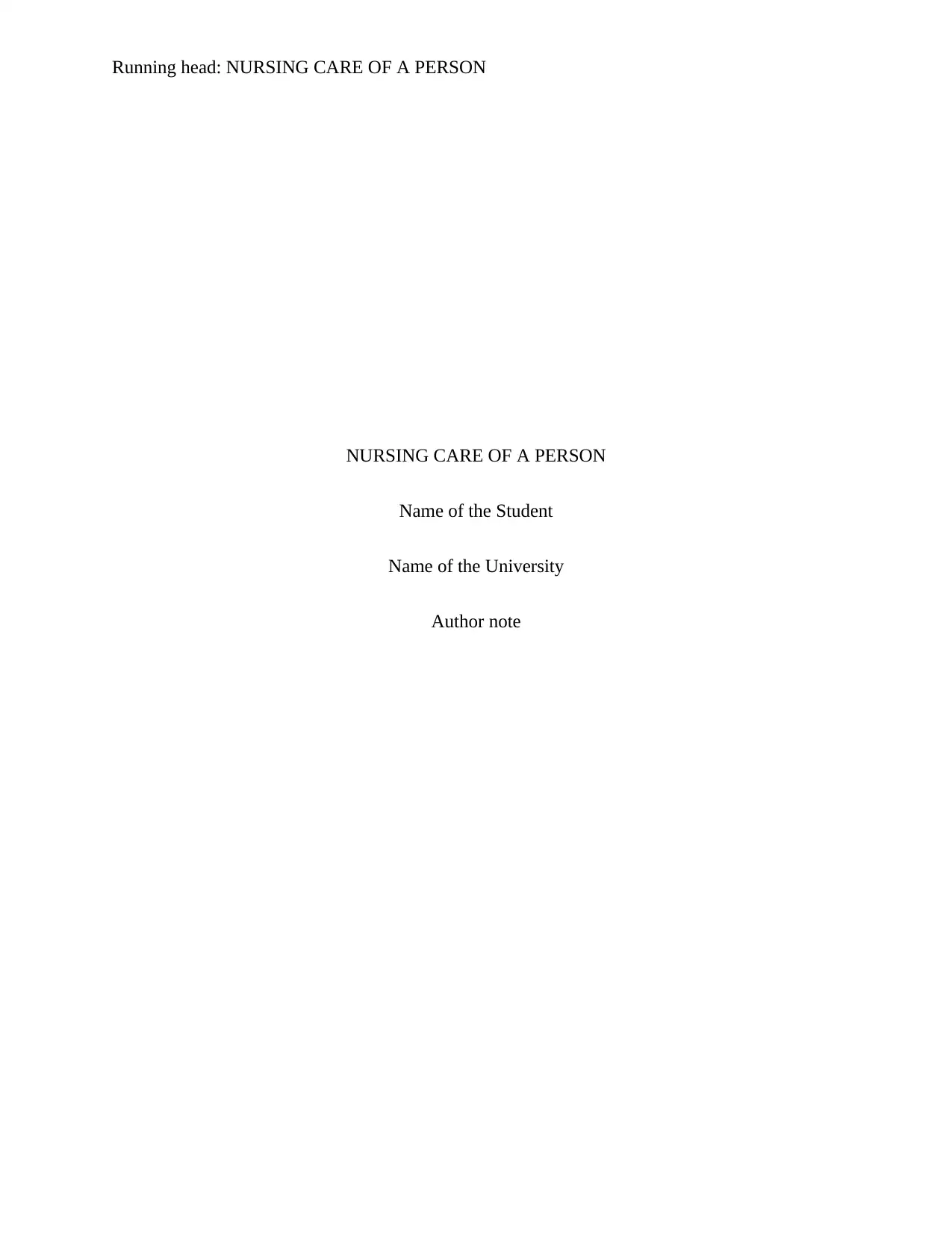
Running head: NURSING CARE OF A PERSON
NURSING CARE OF A PERSON
Name of the Student
Name of the University
Author note
NURSING CARE OF A PERSON
Name of the Student
Name of the University
Author note
Paraphrase This Document
Need a fresh take? Get an instant paraphrase of this document with our AI Paraphraser
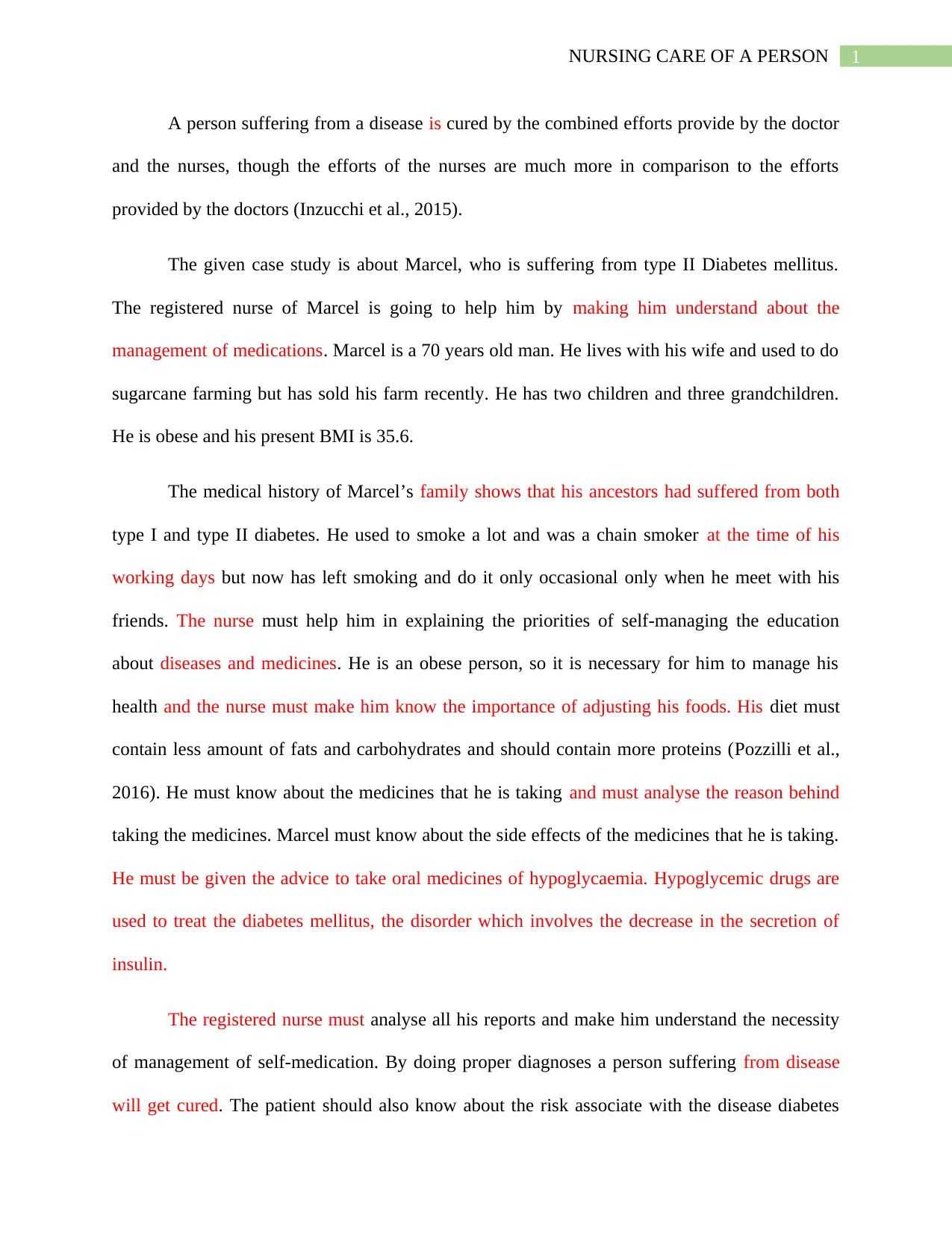
1NURSING CARE OF A PERSON
A person suffering from a disease is cured by the combined efforts provide by the doctor
and the nurses, though the efforts of the nurses are much more in comparison to the efforts
provided by the doctors (Inzucchi et al., 2015).
The given case study is about Marcel, who is suffering from type II Diabetes mellitus.
The registered nurse of Marcel is going to help him by making him understand about the
management of medications. Marcel is a 70 years old man. He lives with his wife and used to do
sugarcane farming but has sold his farm recently. He has two children and three grandchildren.
He is obese and his present BMI is 35.6.
The medical history of Marcel’s family shows that his ancestors had suffered from both
type I and type II diabetes. He used to smoke a lot and was a chain smoker at the time of his
working days but now has left smoking and do it only occasional only when he meet with his
friends. The nurse must help him in explaining the priorities of self-managing the education
about diseases and medicines. He is an obese person, so it is necessary for him to manage his
health and the nurse must make him know the importance of adjusting his foods. His diet must
contain less amount of fats and carbohydrates and should contain more proteins (Pozzilli et al.,
2016). He must know about the medicines that he is taking and must analyse the reason behind
taking the medicines. Marcel must know about the side effects of the medicines that he is taking.
He must be given the advice to take oral medicines of hypoglycaemia. Hypoglycemic drugs are
used to treat the diabetes mellitus, the disorder which involves the decrease in the secretion of
insulin.
The registered nurse must analyse all his reports and make him understand the necessity
of management of self-medication. By doing proper diagnoses a person suffering from disease
will get cured. The patient should also know about the risk associate with the disease diabetes
A person suffering from a disease is cured by the combined efforts provide by the doctor
and the nurses, though the efforts of the nurses are much more in comparison to the efforts
provided by the doctors (Inzucchi et al., 2015).
The given case study is about Marcel, who is suffering from type II Diabetes mellitus.
The registered nurse of Marcel is going to help him by making him understand about the
management of medications. Marcel is a 70 years old man. He lives with his wife and used to do
sugarcane farming but has sold his farm recently. He has two children and three grandchildren.
He is obese and his present BMI is 35.6.
The medical history of Marcel’s family shows that his ancestors had suffered from both
type I and type II diabetes. He used to smoke a lot and was a chain smoker at the time of his
working days but now has left smoking and do it only occasional only when he meet with his
friends. The nurse must help him in explaining the priorities of self-managing the education
about diseases and medicines. He is an obese person, so it is necessary for him to manage his
health and the nurse must make him know the importance of adjusting his foods. His diet must
contain less amount of fats and carbohydrates and should contain more proteins (Pozzilli et al.,
2016). He must know about the medicines that he is taking and must analyse the reason behind
taking the medicines. Marcel must know about the side effects of the medicines that he is taking.
He must be given the advice to take oral medicines of hypoglycaemia. Hypoglycemic drugs are
used to treat the diabetes mellitus, the disorder which involves the decrease in the secretion of
insulin.
The registered nurse must analyse all his reports and make him understand the necessity
of management of self-medication. By doing proper diagnoses a person suffering from disease
will get cured. The patient should also know about the risk associate with the disease diabetes
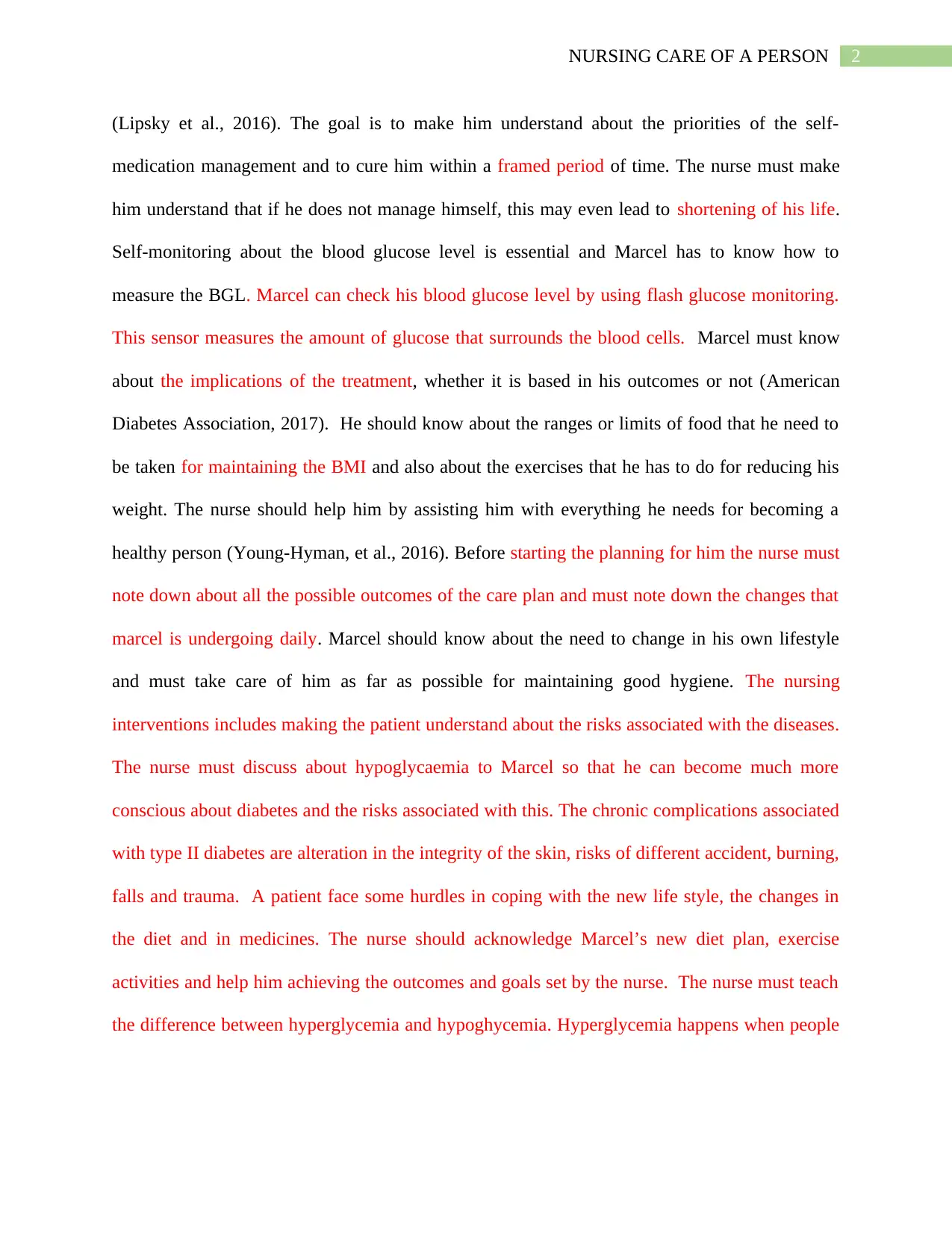
2NURSING CARE OF A PERSON
(Lipsky et al., 2016). The goal is to make him understand about the priorities of the self-
medication management and to cure him within a framed period of time. The nurse must make
him understand that if he does not manage himself, this may even lead to shortening of his life.
Self-monitoring about the blood glucose level is essential and Marcel has to know how to
measure the BGL. Marcel can check his blood glucose level by using flash glucose monitoring.
This sensor measures the amount of glucose that surrounds the blood cells. Marcel must know
about the implications of the treatment, whether it is based in his outcomes or not (American
Diabetes Association, 2017). He should know about the ranges or limits of food that he need to
be taken for maintaining the BMI and also about the exercises that he has to do for reducing his
weight. The nurse should help him by assisting him with everything he needs for becoming a
healthy person (Young-Hyman, et al., 2016). Before starting the planning for him the nurse must
note down about all the possible outcomes of the care plan and must note down the changes that
marcel is undergoing daily. Marcel should know about the need to change in his own lifestyle
and must take care of him as far as possible for maintaining good hygiene. The nursing
interventions includes making the patient understand about the risks associated with the diseases.
The nurse must discuss about hypoglycaemia to Marcel so that he can become much more
conscious about diabetes and the risks associated with this. The chronic complications associated
with type II diabetes are alteration in the integrity of the skin, risks of different accident, burning,
falls and trauma. A patient face some hurdles in coping with the new life style, the changes in
the diet and in medicines. The nurse should acknowledge Marcel’s new diet plan, exercise
activities and help him achieving the outcomes and goals set by the nurse. The nurse must teach
the difference between hyperglycemia and hypoghycemia. Hyperglycemia happens when people
(Lipsky et al., 2016). The goal is to make him understand about the priorities of the self-
medication management and to cure him within a framed period of time. The nurse must make
him understand that if he does not manage himself, this may even lead to shortening of his life.
Self-monitoring about the blood glucose level is essential and Marcel has to know how to
measure the BGL. Marcel can check his blood glucose level by using flash glucose monitoring.
This sensor measures the amount of glucose that surrounds the blood cells. Marcel must know
about the implications of the treatment, whether it is based in his outcomes or not (American
Diabetes Association, 2017). He should know about the ranges or limits of food that he need to
be taken for maintaining the BMI and also about the exercises that he has to do for reducing his
weight. The nurse should help him by assisting him with everything he needs for becoming a
healthy person (Young-Hyman, et al., 2016). Before starting the planning for him the nurse must
note down about all the possible outcomes of the care plan and must note down the changes that
marcel is undergoing daily. Marcel should know about the need to change in his own lifestyle
and must take care of him as far as possible for maintaining good hygiene. The nursing
interventions includes making the patient understand about the risks associated with the diseases.
The nurse must discuss about hypoglycaemia to Marcel so that he can become much more
conscious about diabetes and the risks associated with this. The chronic complications associated
with type II diabetes are alteration in the integrity of the skin, risks of different accident, burning,
falls and trauma. A patient face some hurdles in coping with the new life style, the changes in
the diet and in medicines. The nurse should acknowledge Marcel’s new diet plan, exercise
activities and help him achieving the outcomes and goals set by the nurse. The nurse must teach
the difference between hyperglycemia and hypoghycemia. Hyperglycemia happens when people
⊘ This is a preview!⊘
Do you want full access?
Subscribe today to unlock all pages.

Trusted by 1+ million students worldwide
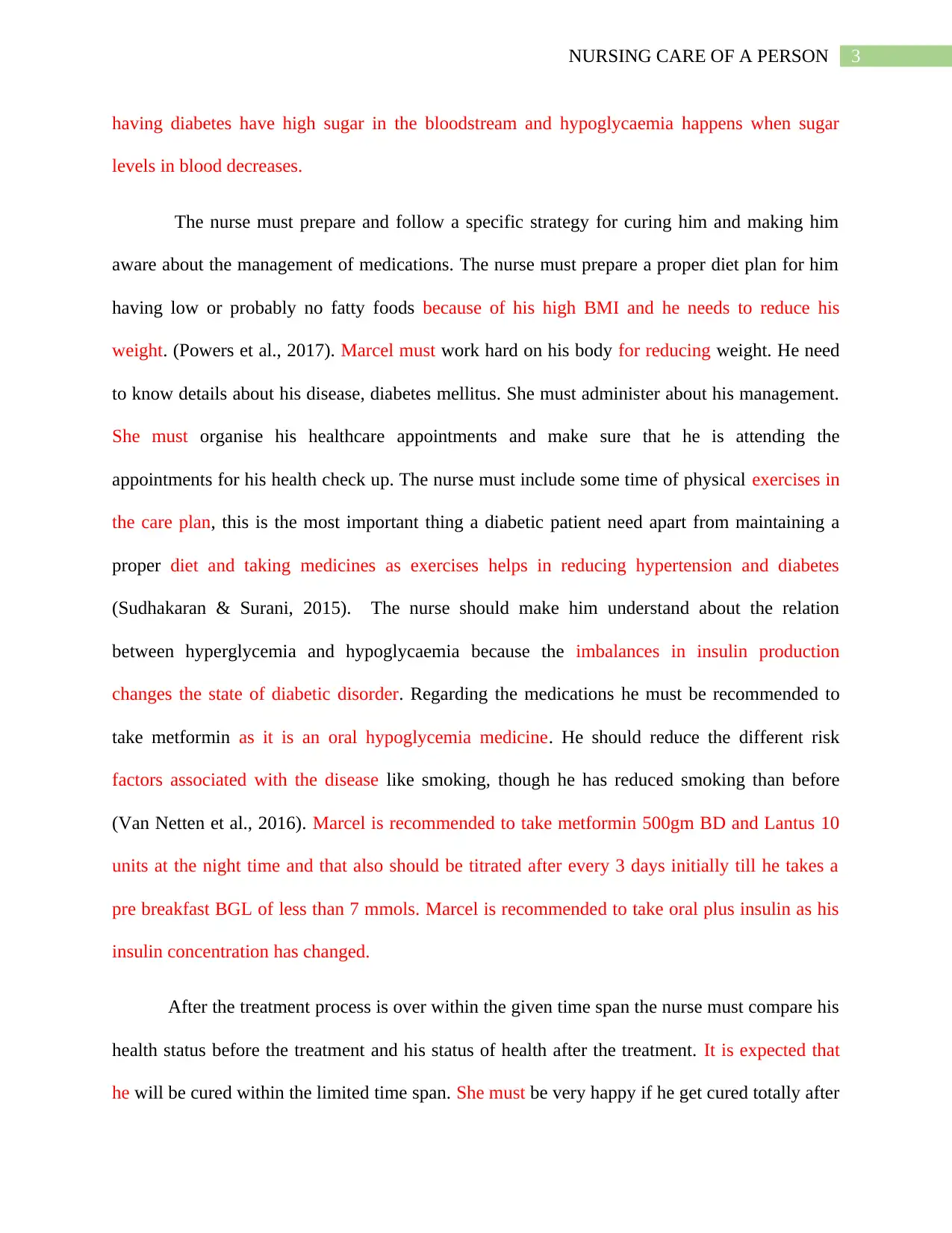
3NURSING CARE OF A PERSON
having diabetes have high sugar in the bloodstream and hypoglycaemia happens when sugar
levels in blood decreases.
The nurse must prepare and follow a specific strategy for curing him and making him
aware about the management of medications. The nurse must prepare a proper diet plan for him
having low or probably no fatty foods because of his high BMI and he needs to reduce his
weight. (Powers et al., 2017). Marcel must work hard on his body for reducing weight. He need
to know details about his disease, diabetes mellitus. She must administer about his management.
She must organise his healthcare appointments and make sure that he is attending the
appointments for his health check up. The nurse must include some time of physical exercises in
the care plan, this is the most important thing a diabetic patient need apart from maintaining a
proper diet and taking medicines as exercises helps in reducing hypertension and diabetes
(Sudhakaran & Surani, 2015). The nurse should make him understand about the relation
between hyperglycemia and hypoglycaemia because the imbalances in insulin production
changes the state of diabetic disorder. Regarding the medications he must be recommended to
take metformin as it is an oral hypoglycemia medicine. He should reduce the different risk
factors associated with the disease like smoking, though he has reduced smoking than before
(Van Netten et al., 2016). Marcel is recommended to take metformin 500gm BD and Lantus 10
units at the night time and that also should be titrated after every 3 days initially till he takes a
pre breakfast BGL of less than 7 mmols. Marcel is recommended to take oral plus insulin as his
insulin concentration has changed.
After the treatment process is over within the given time span the nurse must compare his
health status before the treatment and his status of health after the treatment. It is expected that
he will be cured within the limited time span. She must be very happy if he get cured totally after
having diabetes have high sugar in the bloodstream and hypoglycaemia happens when sugar
levels in blood decreases.
The nurse must prepare and follow a specific strategy for curing him and making him
aware about the management of medications. The nurse must prepare a proper diet plan for him
having low or probably no fatty foods because of his high BMI and he needs to reduce his
weight. (Powers et al., 2017). Marcel must work hard on his body for reducing weight. He need
to know details about his disease, diabetes mellitus. She must administer about his management.
She must organise his healthcare appointments and make sure that he is attending the
appointments for his health check up. The nurse must include some time of physical exercises in
the care plan, this is the most important thing a diabetic patient need apart from maintaining a
proper diet and taking medicines as exercises helps in reducing hypertension and diabetes
(Sudhakaran & Surani, 2015). The nurse should make him understand about the relation
between hyperglycemia and hypoglycaemia because the imbalances in insulin production
changes the state of diabetic disorder. Regarding the medications he must be recommended to
take metformin as it is an oral hypoglycemia medicine. He should reduce the different risk
factors associated with the disease like smoking, though he has reduced smoking than before
(Van Netten et al., 2016). Marcel is recommended to take metformin 500gm BD and Lantus 10
units at the night time and that also should be titrated after every 3 days initially till he takes a
pre breakfast BGL of less than 7 mmols. Marcel is recommended to take oral plus insulin as his
insulin concentration has changed.
After the treatment process is over within the given time span the nurse must compare his
health status before the treatment and his status of health after the treatment. It is expected that
he will be cured within the limited time span. She must be very happy if he get cured totally after
Paraphrase This Document
Need a fresh take? Get an instant paraphrase of this document with our AI Paraphraser
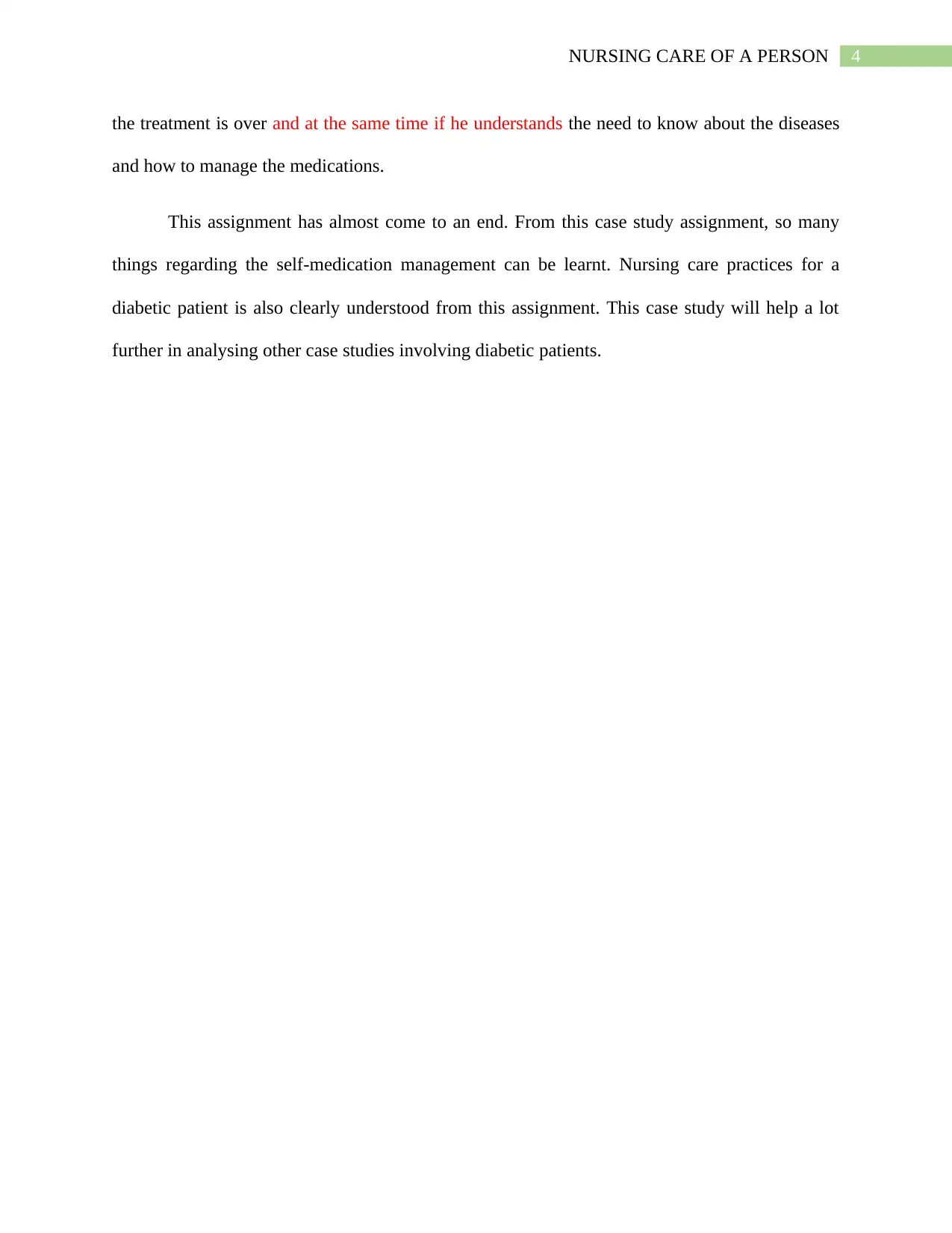
4NURSING CARE OF A PERSON
the treatment is over and at the same time if he understands the need to know about the diseases
and how to manage the medications.
This assignment has almost come to an end. From this case study assignment, so many
things regarding the self-medication management can be learnt. Nursing care practices for a
diabetic patient is also clearly understood from this assignment. This case study will help a lot
further in analysing other case studies involving diabetic patients.
the treatment is over and at the same time if he understands the need to know about the diseases
and how to manage the medications.
This assignment has almost come to an end. From this case study assignment, so many
things regarding the self-medication management can be learnt. Nursing care practices for a
diabetic patient is also clearly understood from this assignment. This case study will help a lot
further in analysing other case studies involving diabetic patients.
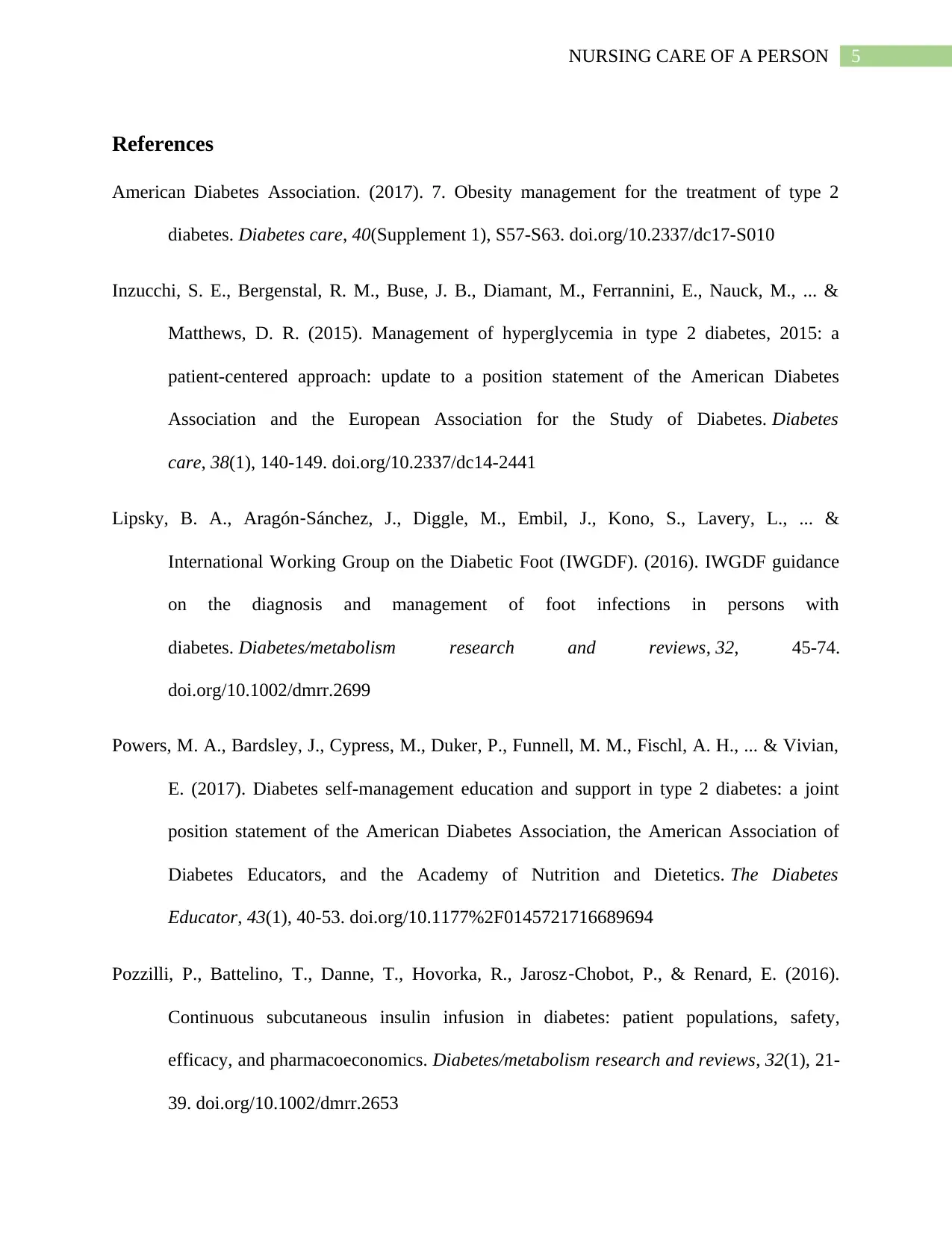
5NURSING CARE OF A PERSON
References
American Diabetes Association. (2017). 7. Obesity management for the treatment of type 2
diabetes. Diabetes care, 40(Supplement 1), S57-S63. doi.org/10.2337/dc17-S010
Inzucchi, S. E., Bergenstal, R. M., Buse, J. B., Diamant, M., Ferrannini, E., Nauck, M., ... &
Matthews, D. R. (2015). Management of hyperglycemia in type 2 diabetes, 2015: a
patient-centered approach: update to a position statement of the American Diabetes
Association and the European Association for the Study of Diabetes. Diabetes
care, 38(1), 140-149. doi.org/10.2337/dc14-2441
Lipsky, B. A., Aragón‐Sánchez, J., Diggle, M., Embil, J., Kono, S., Lavery, L., ... &
International Working Group on the Diabetic Foot (IWGDF). (2016). IWGDF guidance
on the diagnosis and management of foot infections in persons with
diabetes. Diabetes/metabolism research and reviews, 32, 45-74.
doi.org/10.1002/dmrr.2699
Powers, M. A., Bardsley, J., Cypress, M., Duker, P., Funnell, M. M., Fischl, A. H., ... & Vivian,
E. (2017). Diabetes self-management education and support in type 2 diabetes: a joint
position statement of the American Diabetes Association, the American Association of
Diabetes Educators, and the Academy of Nutrition and Dietetics. The Diabetes
Educator, 43(1), 40-53. doi.org/10.1177%2F0145721716689694
Pozzilli, P., Battelino, T., Danne, T., Hovorka, R., Jarosz‐Chobot, P., & Renard, E. (2016).
Continuous subcutaneous insulin infusion in diabetes: patient populations, safety,
efficacy, and pharmacoeconomics. Diabetes/metabolism research and reviews, 32(1), 21-
39. doi.org/10.1002/dmrr.2653
References
American Diabetes Association. (2017). 7. Obesity management for the treatment of type 2
diabetes. Diabetes care, 40(Supplement 1), S57-S63. doi.org/10.2337/dc17-S010
Inzucchi, S. E., Bergenstal, R. M., Buse, J. B., Diamant, M., Ferrannini, E., Nauck, M., ... &
Matthews, D. R. (2015). Management of hyperglycemia in type 2 diabetes, 2015: a
patient-centered approach: update to a position statement of the American Diabetes
Association and the European Association for the Study of Diabetes. Diabetes
care, 38(1), 140-149. doi.org/10.2337/dc14-2441
Lipsky, B. A., Aragón‐Sánchez, J., Diggle, M., Embil, J., Kono, S., Lavery, L., ... &
International Working Group on the Diabetic Foot (IWGDF). (2016). IWGDF guidance
on the diagnosis and management of foot infections in persons with
diabetes. Diabetes/metabolism research and reviews, 32, 45-74.
doi.org/10.1002/dmrr.2699
Powers, M. A., Bardsley, J., Cypress, M., Duker, P., Funnell, M. M., Fischl, A. H., ... & Vivian,
E. (2017). Diabetes self-management education and support in type 2 diabetes: a joint
position statement of the American Diabetes Association, the American Association of
Diabetes Educators, and the Academy of Nutrition and Dietetics. The Diabetes
Educator, 43(1), 40-53. doi.org/10.1177%2F0145721716689694
Pozzilli, P., Battelino, T., Danne, T., Hovorka, R., Jarosz‐Chobot, P., & Renard, E. (2016).
Continuous subcutaneous insulin infusion in diabetes: patient populations, safety,
efficacy, and pharmacoeconomics. Diabetes/metabolism research and reviews, 32(1), 21-
39. doi.org/10.1002/dmrr.2653
⊘ This is a preview!⊘
Do you want full access?
Subscribe today to unlock all pages.

Trusted by 1+ million students worldwide
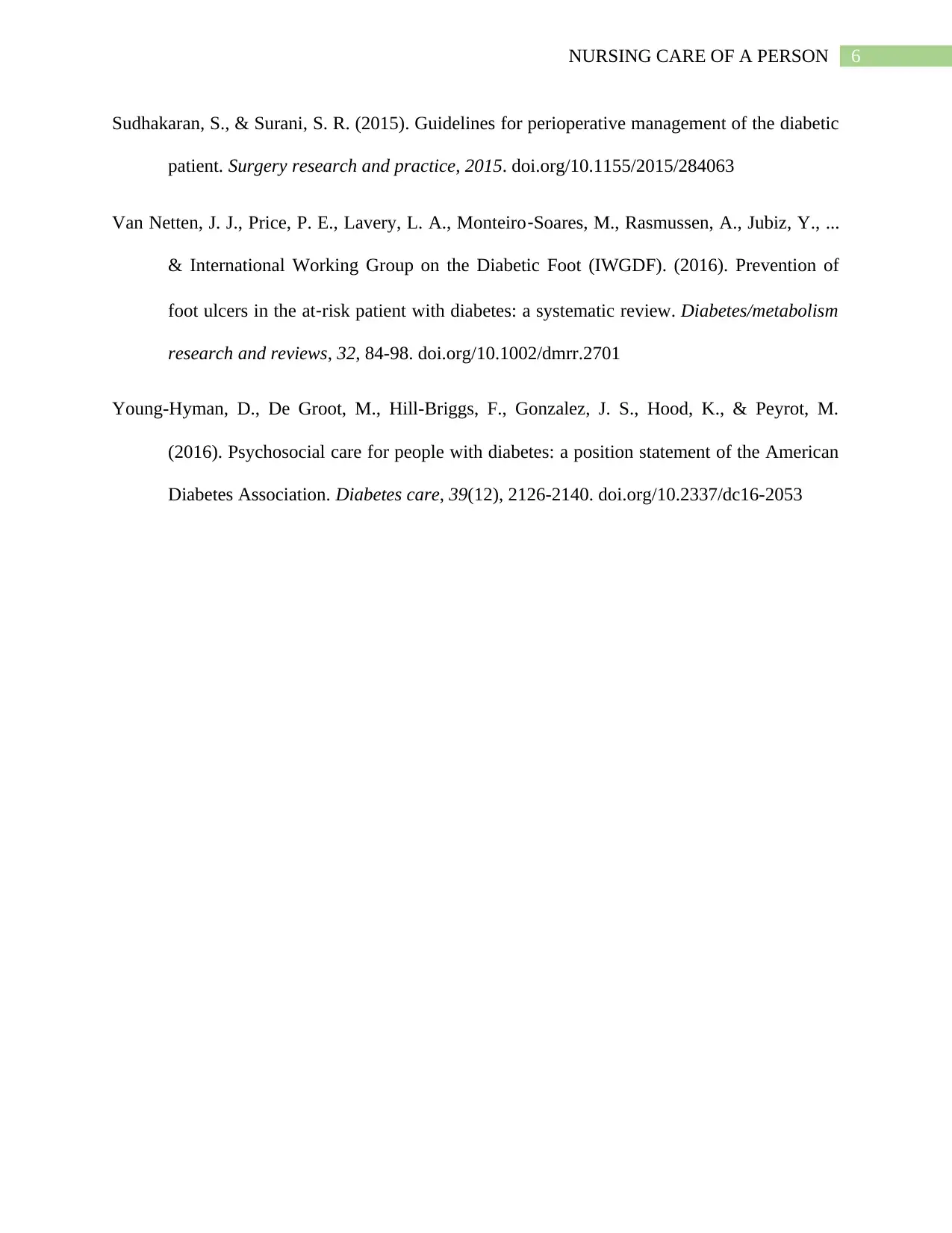
6NURSING CARE OF A PERSON
Sudhakaran, S., & Surani, S. R. (2015). Guidelines for perioperative management of the diabetic
patient. Surgery research and practice, 2015. doi.org/10.1155/2015/284063
Van Netten, J. J., Price, P. E., Lavery, L. A., Monteiro‐Soares, M., Rasmussen, A., Jubiz, Y., ...
& International Working Group on the Diabetic Foot (IWGDF). (2016). Prevention of
foot ulcers in the at‐risk patient with diabetes: a systematic review. Diabetes/metabolism
research and reviews, 32, 84-98. doi.org/10.1002/dmrr.2701
Young-Hyman, D., De Groot, M., Hill-Briggs, F., Gonzalez, J. S., Hood, K., & Peyrot, M.
(2016). Psychosocial care for people with diabetes: a position statement of the American
Diabetes Association. Diabetes care, 39(12), 2126-2140. doi.org/10.2337/dc16-2053
Sudhakaran, S., & Surani, S. R. (2015). Guidelines for perioperative management of the diabetic
patient. Surgery research and practice, 2015. doi.org/10.1155/2015/284063
Van Netten, J. J., Price, P. E., Lavery, L. A., Monteiro‐Soares, M., Rasmussen, A., Jubiz, Y., ...
& International Working Group on the Diabetic Foot (IWGDF). (2016). Prevention of
foot ulcers in the at‐risk patient with diabetes: a systematic review. Diabetes/metabolism
research and reviews, 32, 84-98. doi.org/10.1002/dmrr.2701
Young-Hyman, D., De Groot, M., Hill-Briggs, F., Gonzalez, J. S., Hood, K., & Peyrot, M.
(2016). Psychosocial care for people with diabetes: a position statement of the American
Diabetes Association. Diabetes care, 39(12), 2126-2140. doi.org/10.2337/dc16-2053
1 out of 7
Related Documents
Your All-in-One AI-Powered Toolkit for Academic Success.
+13062052269
info@desklib.com
Available 24*7 on WhatsApp / Email
![[object Object]](/_next/static/media/star-bottom.7253800d.svg)
Unlock your academic potential
Copyright © 2020–2025 A2Z Services. All Rights Reserved. Developed and managed by ZUCOL.





